Russkaya izba: the ark among the woods
 Bashny.Net
Bashny.Net
In the morning the sun was shining, Yes, but a helluva lot of sparrows noisily — a true sign of a Blizzard. Twilight threw frequent snow, and when the wind picked up, sapurina so that outstretched arms can't see. Raged all night and the next day the storm did not lose strength.
Hut covered with snow to the top of the basement, outside the snowdrifts in human growth — not even go to the neighbors, and the outskirts of the village and not out. But to go anywhere especially and is not necessary. Except for the wood in the barn, the woodshed. Supplies in the hut, enough for the whole winter. In the basement — barrels and barrels of pickles, cabbage, mushrooms and cranberries, bags of flour, grain and bran for poultry and other animals, hooks, bacon sausage, dried fish; in the cellar in piles strewn potatoes and other vegetables.
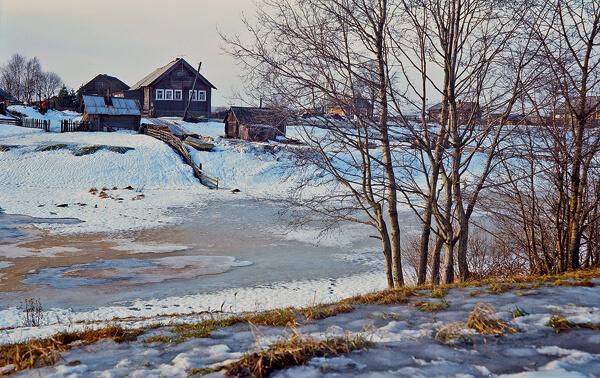
Wooden house with outbuildings in a village in Karelia.
And the farmyard order: two cows chew hay, which up to the roof littered with a layer over them, grunting pigs behind the fence, the bird sleeps on its perch in enclosed in a corner of the coop. Chilly here but no frost. Built of thick logs, carefully caulked the walls of the drafts do not pass and retain heat animals preyuschey manure and straw.
And in the hut on the cold and does not remember — it's hot-heated oven cools down for a long time. That's just kids bored, until the storm is over, out of the house to play, to run will not work. Lying on the bunk, listening to stories that grandpa tells...
In the center of Gorodets in the Nizhny Novgorod region preserved whole streets of wooden houses of the old buildings.
The most ancient Russian hut — up to XIII century was built without a Foundation, almost a third burying in the ground so it was easier to conserve heat. Dug a pit, which was taken to collect the crowns of logs.
To plank flooring was still far away, and they were left earthen. On a thoroughly tamped floor made of stones laid in the hearth. In such a pit-house people spent the winter along with the domestic animals that were kept closer to the entrance. Yes, and the door was not. Very small entrance hole, only to squeeze — covered from the wind and the cold shield from probrain and cloth canopy.
Centuries have passed, and Russkaya izba out from under the ground. Now it is set on a stone Foundation. But if on the pillars, piles, corners draws on the massive deck. Those who are richer, made a roof from tesa, the villagers are poorer wings hut chips-shingled. And doors appeared on wrought-iron hinges, and Windows were cuts through, and the size of farm buildings has increased markedly.
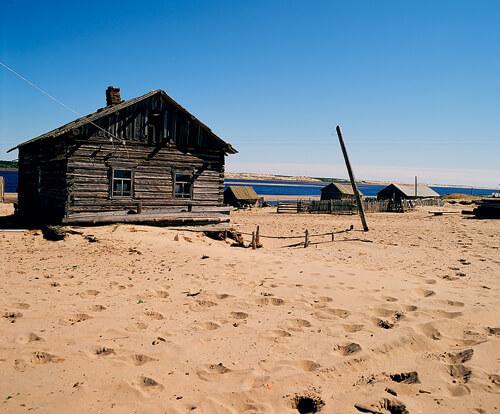
Centennial wooden hut on the shore of the White sea.
We are most familiar with the traditional huts, as they have been preserved in the villages of Russia from the Western to the Eastern limits. This hut-wall, which consists of two rooms — anteroom and a living room, or restistance, when in fact the dwelling divided by another transverse wall into two. These huts were placed in the villages until very recently. But the peasant izba of the Russian North were built differently.
In fact, Northern hut — it's not just a house, and the module full of vital security family of several people during the long, harsh winter and cold spring. A sort of space ship on the joke, the ark, the traveller is not in space but in time — from heat to heat, from harvest to harvest. Human habitation, a room for cattle and poultry, storage of supplies — all under one roof, all under the protection of strong walls. Is that a woodshed and Yes the barn-the barn separately. So they immediately, in the fence, punching them in the snow the trail is not difficult.
This house was built in two tiers. Lower — economic, there is a yard and storage supplies — basement with cellar. The upper — housing of the people, the room (from the word celestial, that is, high because at the top). Heat the barnyard goes up, people knew since time immemorial.
To get into the room from the street, the porch did high. And, climbing it, had to overcome a flight of stairs. But no matter how the storm piled drifts, the entrance to the house, they do not sweep. From the porch a door leads to the vestibule a spacious vestibule, a transition to other areas. Here is various peasant utensils, and in the summer, when the heat comes, in the hallway sleeping. Because it is cool.

Reconstruction of Northern Russian log hut.
Through the canopy you can go down to the barnyard, here is the door into the room. Just get into the room cautiously. For warmth the door is made low and the threshold high. Get those legs up higher Yes, don't forget to duck — uneven hour will stuff a lump on the doorpost.
Spacious basement is located beneath the upper room, the entrance is from the barnyard. Did the basement a height of six, eight or ten rows of crowns. And starting to trade, the owner transformed the basement not only in storage but also in rural trading shop — cut to the street window counter for buyers.
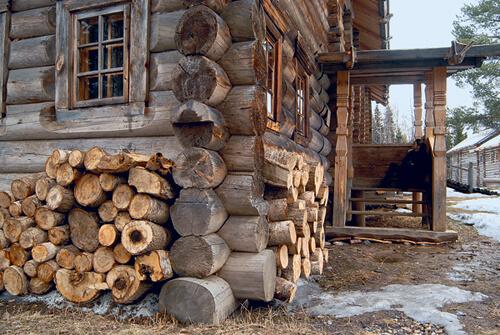
Residential house, built of logs a powerful a hundred years ago.
Built, however, different. In the Museum "Vitoslavlitsy" in Novgorod the hut is generally known as the ocean-going vessel inside the street door starts, moves and transitions in different compartments and to the upper room to reach the ladder-the ladder to climb up under the roof.
Alone this house will not raise up. Because in the Northern rural communities, for young house — new families — put the world. Built the village together, cut and carried wood, sawed huge logs, laid the wreath for the wreath under the roof, had a happy built. Only when there was a stray farm artisans-carpenters, to build housing began to hire them.
North house outside looks huge, and the living room in her one — room area of twenty meters or less. All live there together, and old and small. The house is in the red corner, hanging icon lamp Yes. Here sits the master of the house, invite the guests of honor. The main place of the mistress — in front of the furnace. It is called Kut. A narrow space behind the stove — cube. Hence the expression to live in a cavern in a close corner or a tiny room.
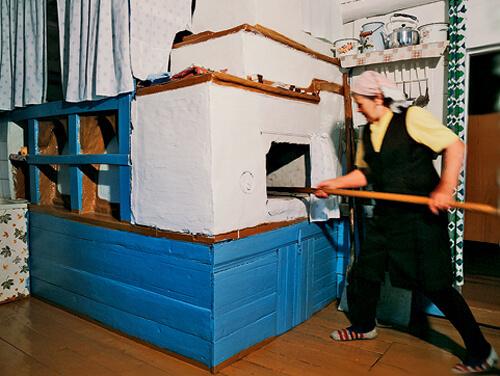
The main in the house brick oven. She and warm, and fed, and sleep was Packed.
"In the upper room of my light..." is sung in a popular not so long ago song. Alas, for a long time it was not so. For the sake of warmth the window in the upper room cut a little, tighten bullish or fish bladder, or oiled canvas, barely missed a light. Only in the rich houses you could see the mica window. Records of this layered mineral was secured in the curved bindings, but the window looked like stained glass. By the way, mica was even the Windows in Voske of Peter I, which is stored in the collection "Hermitage". In the winter the Windows were inserted plates of ice. They cut on the frozen river or amaraiwadi in the form of directly in the yard. Went lighter. However, to prepare a new "ice glass" instead of melting often had. Glass appeared in the Middle ages, but as a building material Russian village knew him only in the NINETEENTH century.
For a long time in rural and in urban huts furnace put without pipes. Not because I do not know how or did not think, and all for the same reasons — as if to preserve heat. Pipe no matter how close the dampers, and the frosty air still penetrates outside, Victoria the house and the furnace has to heat much more often.
The smoke of a furnace came into the room and went outside only through small Windows-demnity under the ceiling, which opened on time in the furnace. And although stoked the furnace well dried "smokeless" wood, smoke in the room was missing. Because the hut was called black or smoky.
The pipe appeared only in XV—XVI centuries, and where the winters were not too harsh. Hut with the pipe were called white. But at first did not pipe stone, and were knocked out of the tree, which often was the cause of the fire. Only in the beginning of XVIII century Peter I special ordered in urban homes of the new capital — Saint-Petersburg, stone or wood, to put furnaces with brick chimneys.
Later in the houses of wealthy farmers in addition to Russian ovens in which the food was prepared were brought to Russia by Peter I of the furnace-Dutch, convenient for its small size and very high emissivity. However furnace without pipes continued to put in the Northern villages until the late nineteenth century.
Stove it and the warm bed — the bed belonging by tradition the eldest in the family. Between the wall and the oven reaches a broad shelf — loft. There is also heat, so on the shelf put to sleep children. The parents were located on benches and on the floor; the time beds had not yet arrived.
Architecture of the Russian izba gradually changed and became more complex. Residential premises. In addition to the anteroom and the room appeared in house Svetlitsa — really bright room with two or three large Windows since these Windows. Now in the front room held a substantial part of the life of the family and the upper room served as a kitchen.
Was heated the front room from the back wall of the furnace. And prosperous peasants divided the expansive living frame hut two walls crisscross, razvarivaya thus four rooms. Even a large Russian stove to heat the whole room could here and had to put in the most distant from it is additionally oven-Dutch girl.
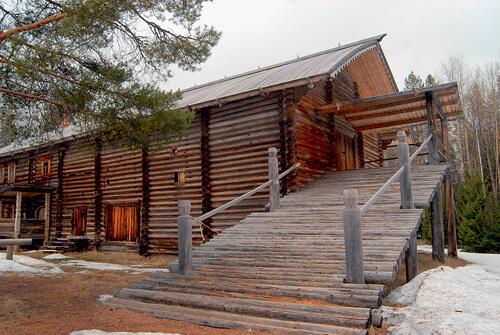
In great Northern, the house the living quarters and farm buildings were located under one roof. To the door of the barn was often built the platform on which the horses were brought the hay in carts.
The storm is raging a week, but under the roof it is almost inaudible. Everything goes on as usual. The mistress of a hassle most of all: early in the morning to milk the cows and pour the grain to the birds. Then steam the bran for the pigs. Water to bring from the village well — two buckets on a yoke, one and a half pounds total weight! But that's not the case, so led since the beginning. Yes, the food needs to cook to feed the family. The kids, of course, than can help.
Men winter less worries. The owner of the house — the breadwinner — working tirelessly all summer. Plowing, mowing, harvest, threshing, chopping, sawing, building, fish produces and animals of the forest. From dawn to dusk. As accumulated, and will live with his family until the next heat. Because winter clothes for men — holiday time. Of course, no man's hands can not do: fix what needs fixing, chop and bring home firewood, brush and walk the horse. And many other things that neither the woman or the children.
Why women in Russia never cutJoe Vitale: the Secret to instant realization of desires
Felled by the skillful hands of the North house stood century. Generations of a house-the ark was still a safe haven in the harsh natural conditions. Only the mighty logs darkened by time. In the museums of wooden architecture "Vitoslavlitsy" in Novgorod the Great and Malye Korely near Arkhangelsk is in public, the age of which exceeded a century and a half. They were looking for in the abandoned villages of the scientists-ethnographers and redeemed living in the city owners. Then carefully dismantled, transported to the Museum grounds and restored in its original form. And so they appear in front of many tourists coming to Great Novgorod and Arkhangelsk.published
Author: Boris Rudenko
Photo: Igor Konstantinov
Source: www.nkj.ru/archive/articles/21349/
Hut covered with snow to the top of the basement, outside the snowdrifts in human growth — not even go to the neighbors, and the outskirts of the village and not out. But to go anywhere especially and is not necessary. Except for the wood in the barn, the woodshed. Supplies in the hut, enough for the whole winter. In the basement — barrels and barrels of pickles, cabbage, mushrooms and cranberries, bags of flour, grain and bran for poultry and other animals, hooks, bacon sausage, dried fish; in the cellar in piles strewn potatoes and other vegetables.

Wooden house with outbuildings in a village in Karelia.
And the farmyard order: two cows chew hay, which up to the roof littered with a layer over them, grunting pigs behind the fence, the bird sleeps on its perch in enclosed in a corner of the coop. Chilly here but no frost. Built of thick logs, carefully caulked the walls of the drafts do not pass and retain heat animals preyuschey manure and straw.
And in the hut on the cold and does not remember — it's hot-heated oven cools down for a long time. That's just kids bored, until the storm is over, out of the house to play, to run will not work. Lying on the bunk, listening to stories that grandpa tells...
In the center of Gorodets in the Nizhny Novgorod region preserved whole streets of wooden houses of the old buildings.
The most ancient Russian hut — up to XIII century was built without a Foundation, almost a third burying in the ground so it was easier to conserve heat. Dug a pit, which was taken to collect the crowns of logs.
To plank flooring was still far away, and they were left earthen. On a thoroughly tamped floor made of stones laid in the hearth. In such a pit-house people spent the winter along with the domestic animals that were kept closer to the entrance. Yes, and the door was not. Very small entrance hole, only to squeeze — covered from the wind and the cold shield from probrain and cloth canopy.
Centuries have passed, and Russkaya izba out from under the ground. Now it is set on a stone Foundation. But if on the pillars, piles, corners draws on the massive deck. Those who are richer, made a roof from tesa, the villagers are poorer wings hut chips-shingled. And doors appeared on wrought-iron hinges, and Windows were cuts through, and the size of farm buildings has increased markedly.

Centennial wooden hut on the shore of the White sea.
We are most familiar with the traditional huts, as they have been preserved in the villages of Russia from the Western to the Eastern limits. This hut-wall, which consists of two rooms — anteroom and a living room, or restistance, when in fact the dwelling divided by another transverse wall into two. These huts were placed in the villages until very recently. But the peasant izba of the Russian North were built differently.
In fact, Northern hut — it's not just a house, and the module full of vital security family of several people during the long, harsh winter and cold spring. A sort of space ship on the joke, the ark, the traveller is not in space but in time — from heat to heat, from harvest to harvest. Human habitation, a room for cattle and poultry, storage of supplies — all under one roof, all under the protection of strong walls. Is that a woodshed and Yes the barn-the barn separately. So they immediately, in the fence, punching them in the snow the trail is not difficult.
This house was built in two tiers. Lower — economic, there is a yard and storage supplies — basement with cellar. The upper — housing of the people, the room (from the word celestial, that is, high because at the top). Heat the barnyard goes up, people knew since time immemorial.
To get into the room from the street, the porch did high. And, climbing it, had to overcome a flight of stairs. But no matter how the storm piled drifts, the entrance to the house, they do not sweep. From the porch a door leads to the vestibule a spacious vestibule, a transition to other areas. Here is various peasant utensils, and in the summer, when the heat comes, in the hallway sleeping. Because it is cool.

Reconstruction of Northern Russian log hut.
Through the canopy you can go down to the barnyard, here is the door into the room. Just get into the room cautiously. For warmth the door is made low and the threshold high. Get those legs up higher Yes, don't forget to duck — uneven hour will stuff a lump on the doorpost.
Spacious basement is located beneath the upper room, the entrance is from the barnyard. Did the basement a height of six, eight or ten rows of crowns. And starting to trade, the owner transformed the basement not only in storage but also in rural trading shop — cut to the street window counter for buyers.

Residential house, built of logs a powerful a hundred years ago.
Built, however, different. In the Museum "Vitoslavlitsy" in Novgorod the hut is generally known as the ocean-going vessel inside the street door starts, moves and transitions in different compartments and to the upper room to reach the ladder-the ladder to climb up under the roof.
Alone this house will not raise up. Because in the Northern rural communities, for young house — new families — put the world. Built the village together, cut and carried wood, sawed huge logs, laid the wreath for the wreath under the roof, had a happy built. Only when there was a stray farm artisans-carpenters, to build housing began to hire them.
North house outside looks huge, and the living room in her one — room area of twenty meters or less. All live there together, and old and small. The house is in the red corner, hanging icon lamp Yes. Here sits the master of the house, invite the guests of honor. The main place of the mistress — in front of the furnace. It is called Kut. A narrow space behind the stove — cube. Hence the expression to live in a cavern in a close corner or a tiny room.

The main in the house brick oven. She and warm, and fed, and sleep was Packed.
"In the upper room of my light..." is sung in a popular not so long ago song. Alas, for a long time it was not so. For the sake of warmth the window in the upper room cut a little, tighten bullish or fish bladder, or oiled canvas, barely missed a light. Only in the rich houses you could see the mica window. Records of this layered mineral was secured in the curved bindings, but the window looked like stained glass. By the way, mica was even the Windows in Voske of Peter I, which is stored in the collection "Hermitage". In the winter the Windows were inserted plates of ice. They cut on the frozen river or amaraiwadi in the form of directly in the yard. Went lighter. However, to prepare a new "ice glass" instead of melting often had. Glass appeared in the Middle ages, but as a building material Russian village knew him only in the NINETEENTH century.
For a long time in rural and in urban huts furnace put without pipes. Not because I do not know how or did not think, and all for the same reasons — as if to preserve heat. Pipe no matter how close the dampers, and the frosty air still penetrates outside, Victoria the house and the furnace has to heat much more often.
The smoke of a furnace came into the room and went outside only through small Windows-demnity under the ceiling, which opened on time in the furnace. And although stoked the furnace well dried "smokeless" wood, smoke in the room was missing. Because the hut was called black or smoky.
The pipe appeared only in XV—XVI centuries, and where the winters were not too harsh. Hut with the pipe were called white. But at first did not pipe stone, and were knocked out of the tree, which often was the cause of the fire. Only in the beginning of XVIII century Peter I special ordered in urban homes of the new capital — Saint-Petersburg, stone or wood, to put furnaces with brick chimneys.
Later in the houses of wealthy farmers in addition to Russian ovens in which the food was prepared were brought to Russia by Peter I of the furnace-Dutch, convenient for its small size and very high emissivity. However furnace without pipes continued to put in the Northern villages until the late nineteenth century.
Stove it and the warm bed — the bed belonging by tradition the eldest in the family. Between the wall and the oven reaches a broad shelf — loft. There is also heat, so on the shelf put to sleep children. The parents were located on benches and on the floor; the time beds had not yet arrived.
Architecture of the Russian izba gradually changed and became more complex. Residential premises. In addition to the anteroom and the room appeared in house Svetlitsa — really bright room with two or three large Windows since these Windows. Now in the front room held a substantial part of the life of the family and the upper room served as a kitchen.
Was heated the front room from the back wall of the furnace. And prosperous peasants divided the expansive living frame hut two walls crisscross, razvarivaya thus four rooms. Even a large Russian stove to heat the whole room could here and had to put in the most distant from it is additionally oven-Dutch girl.

In great Northern, the house the living quarters and farm buildings were located under one roof. To the door of the barn was often built the platform on which the horses were brought the hay in carts.
The storm is raging a week, but under the roof it is almost inaudible. Everything goes on as usual. The mistress of a hassle most of all: early in the morning to milk the cows and pour the grain to the birds. Then steam the bran for the pigs. Water to bring from the village well — two buckets on a yoke, one and a half pounds total weight! But that's not the case, so led since the beginning. Yes, the food needs to cook to feed the family. The kids, of course, than can help.
Men winter less worries. The owner of the house — the breadwinner — working tirelessly all summer. Plowing, mowing, harvest, threshing, chopping, sawing, building, fish produces and animals of the forest. From dawn to dusk. As accumulated, and will live with his family until the next heat. Because winter clothes for men — holiday time. Of course, no man's hands can not do: fix what needs fixing, chop and bring home firewood, brush and walk the horse. And many other things that neither the woman or the children.
Why women in Russia never cutJoe Vitale: the Secret to instant realization of desires
Felled by the skillful hands of the North house stood century. Generations of a house-the ark was still a safe haven in the harsh natural conditions. Only the mighty logs darkened by time. In the museums of wooden architecture "Vitoslavlitsy" in Novgorod the Great and Malye Korely near Arkhangelsk is in public, the age of which exceeded a century and a half. They were looking for in the abandoned villages of the scientists-ethnographers and redeemed living in the city owners. Then carefully dismantled, transported to the Museum grounds and restored in its original form. And so they appear in front of many tourists coming to Great Novgorod and Arkhangelsk.published
Author: Boris Rudenko
Photo: Igor Konstantinov
Source: www.nkj.ru/archive/articles/21349/
Tags
See also
Russian hut.
A resident of the Black Forest defended their home from fire forest fire
Living in a house on wheels
An interesting test of Sigmund Freud - find out himself
My Cuba.
Energy efficient eco house, which is behind the sun
Trichomonas theory of cancer Tamara fistulous
If the wife is shining with joy and charm, the whole house will be filled with light.
How to make a dark room brighter: 5 useful tips















